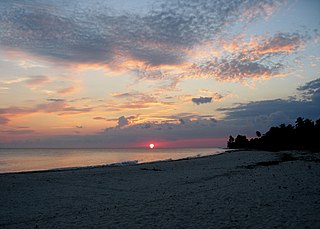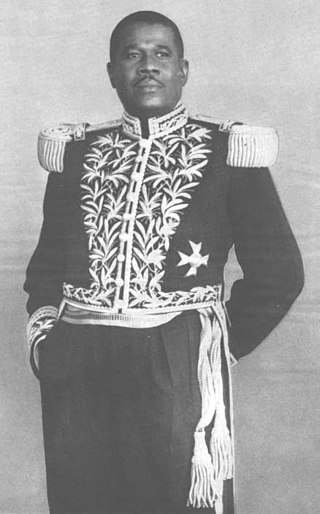This article needs additional citations for verification .(February 2022) |
Magloire Ambroise (Jacmel, Saint-Domingue, 1774 - Port-au-Prince December 7, 1807), was a hero of the Haitian Independence. His military career began in the colonial army. [1]
This article needs additional citations for verification .(February 2022) |
Magloire Ambroise (Jacmel, Saint-Domingue, 1774 - Port-au-Prince December 7, 1807), was a hero of the Haitian Independence. His military career began in the colonial army. [1]
During the War of Knives between Toussaint Louverture in the North against the mulattoes leader André Rigaud in the South (1799–1801), Magloire saved the lives of hundred of respected families in Jacmel. As a result, he was regarded as a hero by the people of that town at this time. In 1802, Jean-Jacques Dessalines named him commander of Jacmel. However, the French troops captured the town as they did in many towns in the country at that time. In 1803, Magloire Ambroise put a siege in Jacmel. The siege was over on October 17, 1803, when the French troops surrendered and were allowed by Magloire's troops to board a British warship.
In 1804, Magloire Ambroise was one of the generals who signed the independence act. In February 1806, by the order of Dessalines, Magloire Ambroise received Francisco de Miranda (a South American leader who fought to liberate Latin America from Spanish rule) and gave Miranda munitions and men to fight the Spaniards. the following month, March 12, 1806, the Venezuelan flag was born in the harbor of Jacmel. [2] In Venezuela, this day is celebrated as flag's day. Notice also the Venezuelan flag has red and blue which symbolizes their friendship with Haiti.
In 1807, Magloire Ambroise became president of the senate and his troops even named him president of the republic. however, he didn't accept this offer. He was arrested by general Bonnet under the order of Alexandre Pétion. [3] he died in prison on December 7, 1807. some sources say he committed suicide while other claim Pétion killed him in prison. In fact, after his death Pétion became the new head of the senate and later became president of the Republic. [4]
The recorded history of Haiti began in 1492, when the European captain and explorer Christopher Columbus landed on a large island in the region of the western Atlantic Ocean that later came to be known as the Caribbean. The western portion of the island of Hispaniola, where Haiti is situated, was inhabited by the Taíno and Arawakan people, who called their island Ayiti. The island was promptly claimed for the Spanish Crown, where it was named La Isla Española, later Latinized to Hispaniola. By the early 17th century, the French had built a settlement on the west of Hispaniola and called it Saint-Domingue. Prior to the Seven Years' War (1756–1763), the economy of Saint-Domingue gradually expanded, with sugar and, later, coffee becoming important export crops. After the war which had disrupted maritime commerce, the colony underwent rapid expansion. In 1767, it exported indigo, cotton and 72 million pounds of raw sugar. By the end of the century, the colony encompassed a third of the entire Atlantic slave trade.

Henri Christophe was a key leader in the Haitian Revolution and the only monarch of the Kingdom of Haiti.

Jean-Pierre Boyer was one of the leaders of the Haitian Revolution, and the president of Haiti from 1818 to 1843. He reunited the north and south of the country into the Republic of Haiti in 1820 and also annexed the newly independent Spanish Haiti, which brought all of Hispaniola under one Haitian government by 1822. Serving as president for just under 25 years, Boyer managed to rule for the longest period of time of any Haitian leader.

Jean-Jacques Dessalines was the first Haitian Emperor, and leader of the Haitian Revolution, and the first ruler of an independent Haiti under the 1805 constitution. Initially regarded as governor-general, Dessalines was later named Emperor of Haiti as Jacques I (1804–1806) by generals of the Haitian Revolutionary army and ruled in that capacity until being assassinated in 1806. He spearheaded the resistance against French massacres upon Haitians, and eventually became the architect of the 1804 Haitian Massacre against the remaining French residents of Haiti, including some supporters of the revolution. He has been referred to as the father of the nation of Haiti.

Alexandre Sabès Pétion was the first president of the Republic of Haiti from 1807 until his death in 1818. One of Haiti's founding fathers, Pétion belonged to the revolutionary quartet that also includes Toussaint Louverture, Jean-Jacques Dessalines, and his later rival Henri Christophe. Regarded as an excellent artilleryman in his early adulthood, Pétion would distinguish himself as an esteemed military commander with experience leading both French and Haitian troops. The 1802 coalition formed by him and Dessalines against French forces led by Charles Leclerc would prove to be a watershed moment in the decade-long conflict, eventually culminating in the decisive Haitian victory at the Battle of Vertières in 1803.

The flag of Haiti is the national flag of the Republic of Haiti. It is a bicolour flag featuring two horizontal bands coloured blue and red, emblazoned by a white rectangular panel bearing the coat of arms of Haiti. The coat of arms depicts a trophy of weapons atop a green hill and a royal palm symbolizing independence. The palm is topped by the Cap of Liberty. The motto L'Union fait la Force appears on a white ribbon below the arrangement.

Ouest (French) or Lwès is one of the ten departments of Haiti. It is located in south-central Haiti, linking the Great-North and the Tiburon Peninsula.

Sud (French) or Sid is one of the ten departments of Haiti and located in southern Haiti. It has an area of 2,653.60 square kilometres (1,024.56 sq mi) and a population of 774,976. Its capital is Les Cayes.

Sud-Est (French) or Sidès is one of the ten departments of Haiti located in southern Haiti. It has an area of 2,034.10 km2 and a population of 632,601 (2015). Its capital is Jacmel.

Paul Eugène Magloire, nicknamed Kanson Fè, was the Haitian president from 1950 to 1956.

Jacmel is a commune in southern Haiti founded by the Spanish in 1504 and repopulated by the French in 1698. It is the capital of the department of Sud-Est, 24 miles (39 km) southwest of Port-au-Prince across the Tiburon Peninsula, and has an estimated population of 40,000, while the commune of Jacmel had a population of 137,966 at the 2003 Census. The town's name is derived from its indigenous Taíno name of Yaquimel. In 1925, Jacmel was dubbed as the "City of Light," becoming the first in the Caribbean to have electricity.

The Kingdom of Haiti was the state established by Henri Christophe on 28 March 1811 when he proclaimed himself King Henri I after having previously ruled as president of the State of Haiti, in the northern part of the country. This was Haiti's second attempt at monarchical rule, as Jean-Jacques Dessalines had previously ruled over the First Empire of Haiti as Emperor Jacques I from 1804 until his assassination in 1806.

The State of Haiti was the name of the state in northern Haiti. It was created on 17 October 1806 following the assassination of Emperor Jacques I and the overthrow of the First Empire of Haiti. The northern State of Haiti was ruled by Henri Christophe originally as Provisional Chief of the Haitian Government from 17 October 1806 until 17 February 1807 when he became President of the State of Haiti. The 1807 constitution for the State of Haiti made the post of president a position for life with the president having the power to appoint his successor. On 28 March 1811 President Henri was proclaimed King Henri I, thereby dissolving the State of Haiti and creating the Kingdom of Haiti.

The First Empire of Haiti, officially known as the Empire of Haiti, was an elective monarchy in North America. Haiti was controlled by France before declaring independence on 1 January 1804. The Governor-General of Haiti, Jean-Jacques Dessalines, created the empire on 22 September 1804. After being proclaimed emperor by the Generals of the Haitian Revolution Army, he held his coronation ceremony on 6 October and took the name Jacques I. The constitution of 20 May 1805, set out the way the empire was to be governed, with the country split into six military divisions. The general of each division corresponded directly with the emperor or the general in chief appointed by the emperor. The constitution also set out the succession to the throne, with the crown being elective and the reigning emperor having the power to appoint his successor. The constitution also banned white people, with the exception of naturalised Germans and Poles, from owning property inside the empire.
The War of Knives, also known as the War of the South, was a civil war from June 1799 to July 1800 between the Haitian revolutionary Toussaint Louverture, a black ex-slave who controlled the north of Saint-Domingue, and his adversary André Rigaud, a mixed-race free person of color who controlled the south. Louverture and Rigaud fought over de facto control of the French colony of Saint-Domingue during the war. Their conflict followed the withdrawal of British forces from the colony earlier during the Haitian Revolution. The war resulted in Toussaint taking control of the entirety of Saint-Domingue, and Rigaud fleeing into exile.
Bruno Blanchet (1760–1822) was an interim president of the Republic of Haiti.

The Indigenous Army, also known as the Army of Saint-Domingue or Lame Endijèn in Haitian Creole, was the name bestowed to the coalition of anti-slavery men and women who fought in the Haitian Revolution in Saint-Domingue. Encompassing both black slaves, maroons, and affranchis, the rebels were not officially titled the Armée indigène until January 1803, under the leadership of then-general Jean-Jacques Dessalines. Predated by insurrectionists such as François Mackandal, Vincent Ogé and Dutty Boukman, Toussaint Louverture, succeeded by Dessalines, led, organized, and consolidated the rebellion. The now full-fledged fighting force utilized its manpower advantage and strategic capacity to overwhelm French troops, ensuring the Haitian Revolution was the most successful of its kind.
Etienne Elie Gérin was a Haitian military and politician.
Nicolas Geffrard was a Haitian general, and a participant in the Haitian Revolution. He was a signatory to the Haitian Declaration of Independence.
In 1789 is made the Declaration of the Rights of Man and of the Citizen, set by France's National Constituent Assembly. In 1791, the enslaved Africans of Saint-Domingue began the Haitian Revolution, aimed at the overthrow of the colonial regime.
{{cite web}}: CS1 maint: numeric names: authors list (link){{cite web}}: Check |url= value (help)